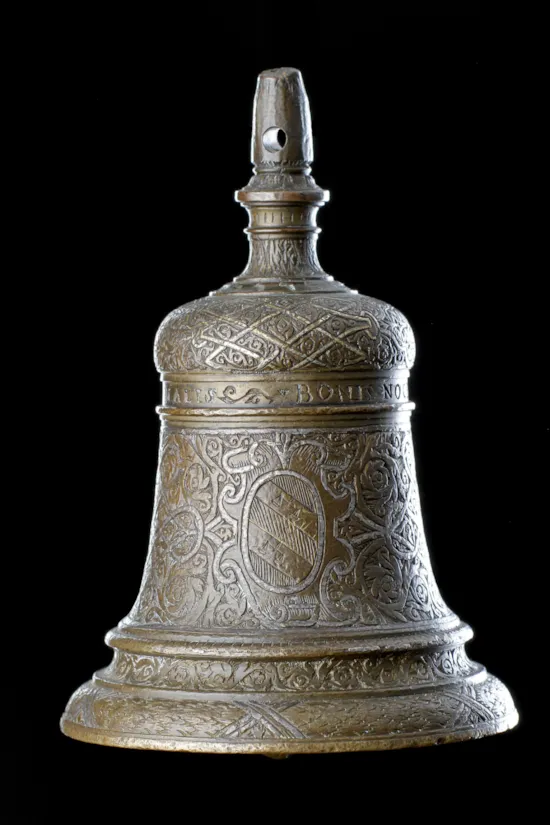Venetian Renaissance Damascened and Engraved Bronze Court Table Bell
A Rare Venetian Renaissance Damascened and Engraved Bronze Court Table Bell with Armourials to either side showing the Scales of Justice
Inscribed in latin ‘Bonis Nocet Quis Peper Cerit Malis’ translating as ‘He Hurts the Good Who Spares the Bad’
Dated to the inner rim 1559 and with original bronze clapper
Top of handle missing
Smooth aged greenish brown patina with extensive silver and gold inlay remaining
Mid 16th Century
Size: 11.5cm high, 8cm dia. - 4½ ins high, 8 ins dia.
cf: Another Venetian Bronze Handbell Circa 1550 in the Ashmolean Museum Oxford Inscribed ‘Pvlsv Meo Servos Voco: With My Ring I Call My Servants’
In the painting by Vittore Carpaccio ‘Vision of Saint Augustine’ Venice 1502, a very similar hand bell sits by the Saint’s elbow on his study table
Inscribed in latin ‘Bonis Nocet Quis Peper Cerit Malis’ translating as ‘He Hurts the Good Who Spares the Bad’
Dated to the inner rim 1559 and with original bronze clapper
Top of handle missing
Smooth aged greenish brown patina with extensive silver and gold inlay remaining
Mid 16th Century
Size: 11.5cm high, 8cm dia. - 4½ ins high, 8 ins dia.
cf: Another Venetian Bronze Handbell Circa 1550 in the Ashmolean Museum Oxford Inscribed ‘Pvlsv Meo Servos Voco: With My Ring I Call My Servants’
In the painting by Vittore Carpaccio ‘Vision of Saint Augustine’ Venice 1502, a very similar hand bell sits by the Saint’s elbow on his study table
A Rare Venetian Renaissance Damascened and Engraved Bronze Court Table Bell with Armourials to either side showing the Scales of Justice
Inscribed in latin ‘Bonis Nocet Quis Peper Cerit Malis’ translating as ‘He Hurts the Good Who Spares the Bad’
Dated to the inner rim 1559 and with original bronze clapper
Top of handle missing
Smooth aged greenish brown patina with extensive silver and gold inlay remaining
Mid 16th Century
Size: 11.5cm high, 8cm dia. - 4½ ins high, 8 ins dia.
Inscribed in latin ‘Bonis Nocet Quis Peper Cerit Malis’ translating as ‘He Hurts the Good Who Spares the Bad’
Dated to the inner rim 1559 and with original bronze clapper
Top of handle missing
Smooth aged greenish brown patina with extensive silver and gold inlay remaining
Mid 16th Century
Size: 11.5cm high, 8cm dia. - 4½ ins high, 8 ins dia.
Damascened work was popular in the mid 16th century on armour and weapons and an Italianate metalwork tradition derived from Islamic prototypes grew up to meet the wealthy indigenous demand. Sometimes referred to as Veneto-Saracenic decoration, interlaced foliate ornament and arabesque patterns were engraved with the use of silver wire inlays. Greatly influenced by the import into Venice of early 16th century Iranian metalwork, a new style of ornamentation developed combining Islamic motifs with European ancient classical decorative traditions.
The quote engraved on the body of the bell is from Publilius Syrus (85 - 43 B.C) a Roman slave from Syria, who by his wit and talent won the favour of his master who educated him and granted him his freedom. Known for his moral maxims and his theatrical mimes and improvisations he became a favourite of Julius Caesar. He is particularly remembered for a number of pertinent sayings such as ‘Iudex Damnatur Ubi Nocens Absolvitur: The Judge is Condemned When the Guilty is Acquitted’. He is also famous for the proverbial maxim ‘A rolling stone gathers no moss’.
The quote engraved on the body of the bell is from Publilius Syrus (85 - 43 B.C) a Roman slave from Syria, who by his wit and talent won the favour of his master who educated him and granted him his freedom. Known for his moral maxims and his theatrical mimes and improvisations he became a favourite of Julius Caesar. He is particularly remembered for a number of pertinent sayings such as ‘Iudex Damnatur Ubi Nocens Absolvitur: The Judge is Condemned When the Guilty is Acquitted’. He is also famous for the proverbial maxim ‘A rolling stone gathers no moss’.
With Danny Katz London early 1980’s
Ex collection Michael and Jane Dunn New York
Ex Frank Cowan New York 1990’s
Thence by descent sold by his widow to Ross Levett Maine USA
Ex Private American collection acquired 2008 from the above
cf: Another Venetian Bronze Handbell Circa 1550 in the Ashmolean Museum Oxford Inscribed ‘Pvlsv Meo Servos Voco: With My Ring I Call My Servants’
In the painting by Vittore Carpaccio ‘Vision of Saint Augustine’ Venice 1502, a very similar hand bell sits by the Saint’s elbow on his study table
Ex collection Michael and Jane Dunn New York
Ex Frank Cowan New York 1990’s
Thence by descent sold by his widow to Ross Levett Maine USA
Ex Private American collection acquired 2008 from the above
cf: Another Venetian Bronze Handbell Circa 1550 in the Ashmolean Museum Oxford Inscribed ‘Pvlsv Meo Servos Voco: With My Ring I Call My Servants’
In the painting by Vittore Carpaccio ‘Vision of Saint Augustine’ Venice 1502, a very similar hand bell sits by the Saint’s elbow on his study table
Venetian Renaissance Damascened and Engraved Bronze Court Table Bell

SOLD






YOU MAY ALSO LIKE

